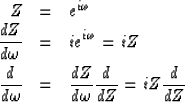In this section we consider filters with
constant unit spectra, that is,
![]() .In other words, in the frequency domain B(Z)
takes the form
.In other words, in the frequency domain B(Z)
takes the form ![]() where
where
![]() is real and is called the phase shift.
Clearly
is real and is called the phase shift.
Clearly ![]() for all real
for all real ![]() .It is an easy matter to construct a filter
with any desired phase shift;
one merely Fourier transforms
.It is an easy matter to construct a filter
with any desired phase shift;
one merely Fourier transforms
![]() into the time domain.
If
into the time domain.
If ![]() is arbitrary,
the resulting time function is likely to
be two-sided. Since we are interested in physical processes
which are causal, we may wonder what class of functions
is arbitrary,
the resulting time function is likely to
be two-sided. Since we are interested in physical processes
which are causal, we may wonder what class of functions
![]() corresponds to one-sided time functions.
The easiest way to proceed is to begin with a simple case
of a single-pole, single-zero all-pass filter.
Then more elaborate all-pass filters can be made up
by cascading these simple filters. Consider the filter
corresponds to one-sided time functions.
The easiest way to proceed is to begin with a simple case
of a single-pole, single-zero all-pass filter.
Then more elaborate all-pass filters can be made up
by cascading these simple filters. Consider the filter
| |
(35) |
Note that this is a simple case of functions
of the form ![]() , where A(Z) is a
polynomial of degree N or less. Now observe that
the spectrum of the filter pt is indeed a
frequency-independent constant. The spectrum is
, where A(Z) is a
polynomial of degree N or less. Now observe that
the spectrum of the filter pt is indeed a
frequency-independent constant. The spectrum is
| |
(36) |
Multiply top and bottom on the left by Z. We now have
| |
(37) |
It is easy to show that ![]() for the general form
for the general form ![]() .If Z0 is chosen outside the unit circle,
then the denominator of (35) can be
expanded in positive powers of Z and the expansion
in convergent on the unit circle.
This means that causality is equivalent to Z0 outside the unit circle.
Setting the numerator of P(Z) equal to zero,
we discover that the zero
.If Z0 is chosen outside the unit circle,
then the denominator of (35) can be
expanded in positive powers of Z and the expansion
in convergent on the unit circle.
This means that causality is equivalent to Z0 outside the unit circle.
Setting the numerator of P(Z) equal to zero,
we discover that the zero ![]() is then
inside the unit circle.
The situation is depicted in Figure 17.
To see that the pole and zero are on the same radius line,
express Z0 in polar form
is then
inside the unit circle.
The situation is depicted in Figure 17.
To see that the pole and zero are on the same radius line,
express Z0 in polar form
![]() .
.
|
2-17
Figure 17 The pole of the all-phase filter lies outside the unit circle and the zero is inside. They lie on the same radius line. |  |
From Section 2.2 (on minimum phase) we see
that the numerator of P is not minimum phase
and its phase is augmented by ![]() as
as ![]() goes from 0 to
goes from 0 to ![]() .Thus the average delay
.Thus the average delay
![]() is positive.
Not only is the average positive but, in fact,
the group delay turns out to be positive in every
frequency. To see this, first note that
is positive.
Not only is the average positive but, in fact,
the group delay turns out to be positive in every
frequency. To see this, first note that
 |
||
| (38) |
The phase of the all-pass filter (or any complex number) may be written as
| |
(39) |
![\begin{eqnarray}
\phi
&= & {1 \over i} \ln P(Z) \eq
{1 \over i} \ln {Z -1/ \ba...
...ver Z_0} \right)
- \ln \left ( 1 - {Z \over Z_0} \right) \right ]\end{eqnarray}](img104.gif) |
||
| (40) |
Using (38) the group delay is now found to be
 |
||
| (41) |
The numerator of (41) is a positive real number
(since ![]() ), and the denominator is of the
form
), and the denominator is of the
form ![]() , which is a spectrum
and also positive. Thus we have shown that the group
delay of this causal all-pass filter is always positive.
, which is a spectrum
and also positive. Thus we have shown that the group
delay of this causal all-pass filter is always positive.
Now if we take a filter and follow it will an all-pass filter, the phases add and the group delay of the composite filter must necessarily be greater than the group delay of original filter. By the same reasoning the minimum-phase filter must have less group delay than any other filter with the same spectrum.
In summary, a single-pole, single-zero all-pass filter passes all frequency components with constant gain and a phase shift which may be adjusted by the placement of a pole. Taking Z0 near the unit circle causes most of the phase shift to be concentrated near the frequency where the pole is located. Taking the pole further away causes the delay to be spread over more frequencies. Complicated phase shifts or group delays may be built up by cascading several single-pole filters.